Anki Settings: A Complete Guide and Recommended Settings For Medical School39 min read
I have slaved over perfecting my Anki settings. I spend about 3-5 hours on Anki every day. I started doing Anki religiously in November of 2019, which is about 2,300 hours on Anki. That’s crazy. I know it’s crazy though. So If I am this crazy, and spending this much of my precious life with Anki, I better be using it as best as I can.
If you want to just skip to screenshots of my settings just click here.
I have found the settings, that I think, work best. These settings avoid “Ease Hell,” optimize retention within a 1-2 year time period (the first two years of medical school), and prevent excessive card buildup. Also, I have tried to tinker with these settings for understanding as opposed to memorization. I want to understand, not memorize, these cards.
In this post, I will show you every one of my Anki settings and the explanation behind each one as well.
If you are completely new to Anki in Medical school I have a post on setting up Anki with the AnKing for the first time here.
General Settings
As a disclaimer, these are just the settings I have found to work best for me in medical school. These may not be optimal settings for learning other things such as a new language or for how you learn individually. There are no “perfect” settings. You should read this post to get a good understanding of what the Anki settings and algorithms mean and “good” settings to start off with. Then, play around with them to match your learning style.
My settings are adapted from the AnKing’s, Conaanaa’s, and MedShamin’s guides. I noticed, about 6 months in that certain settings weren’t working out as well for me, like the “again” setting and max-time interval. I adjusted those to work for me. This is a long, but I think fairly helpful post. Buckle in.
Let’s start with preferences.
To access preferences go to:
Top Toolbar → Anki → Preferences
Basic
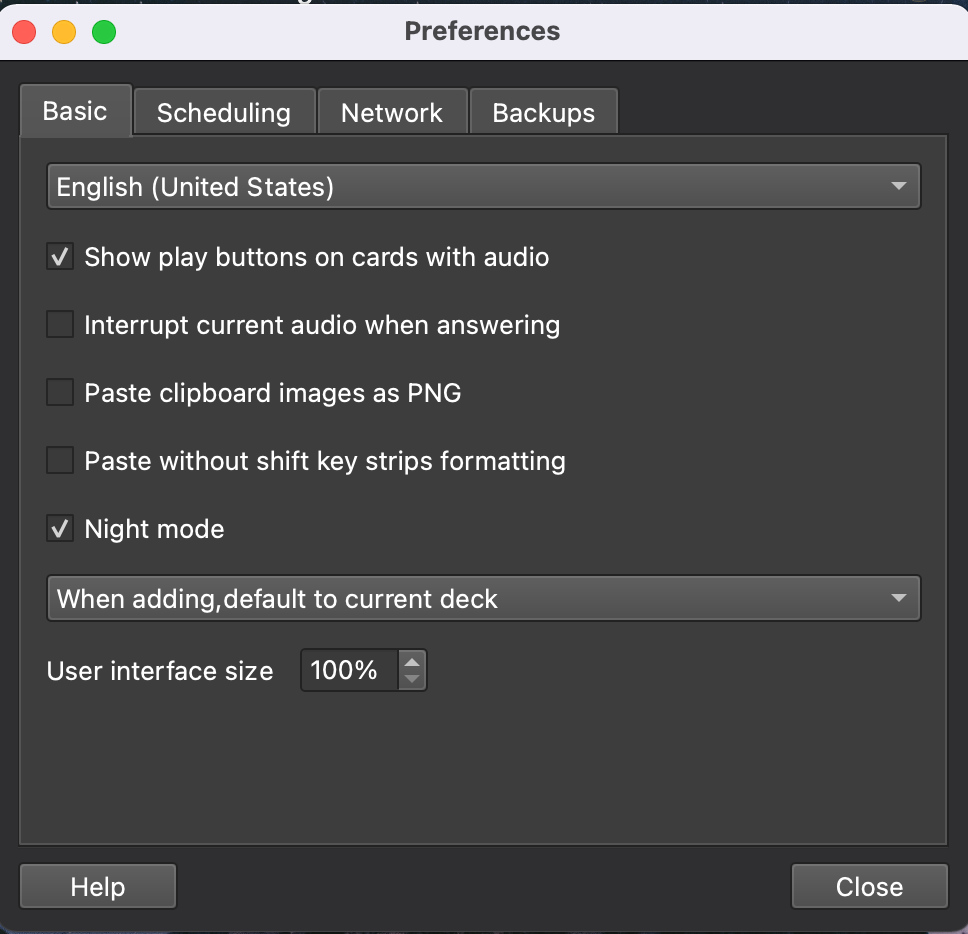
The only thing worth mentioning here is “Night Mode.” This setting makes my deck have a gray background normally with white text. Night mode means certain things about my Anki will look different, as shown on my Anki below:
If you want a guide on how to customize your Anki background click here.
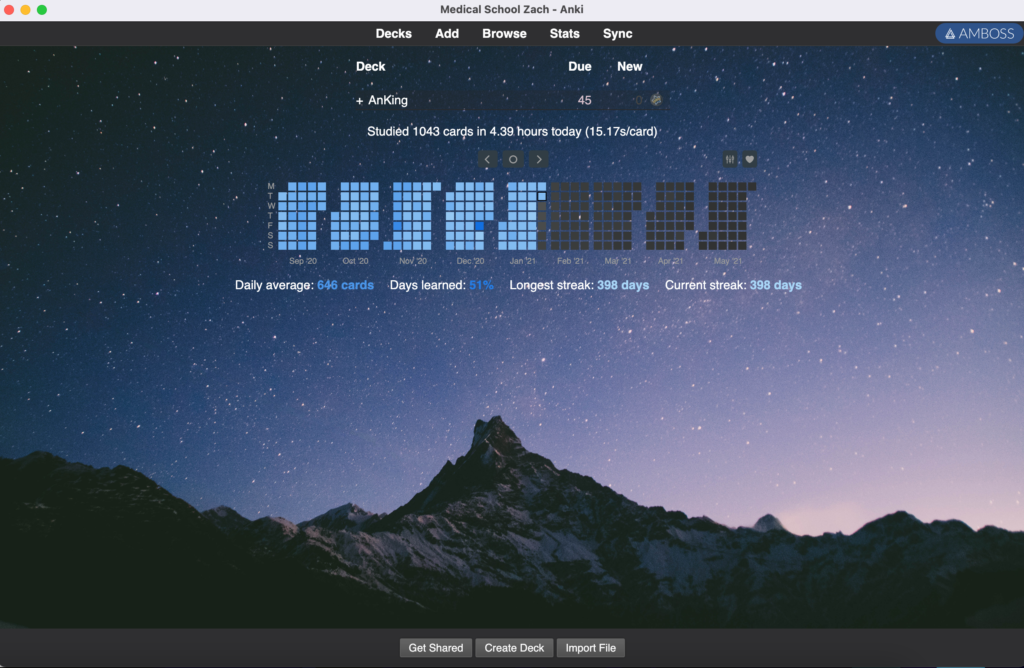
Scheduling
This is the most important section in preferences.
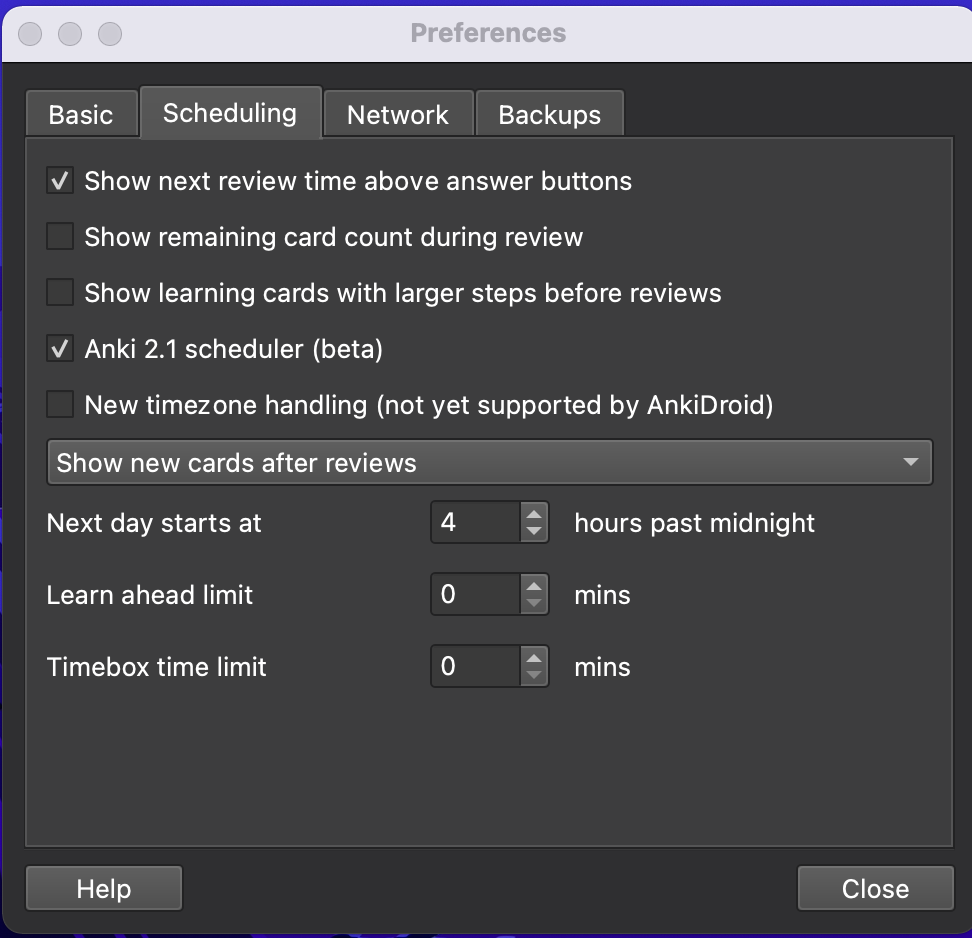

“Show next review time above answer buttons” is the difference between this:

and this:

I think it’s better to leave it enabled so you can monitor to see if Anki is doing anything funky with your review times. Also, it’s beneficial to know how far in the future your cards are being pushed if you have an exam coming up.
For example, my Step 1 exam is in 2 months, so I know if I see “3 months” on the “good” button, I better know that card because I won’t be seeing it again before I take my exam.

I leave “show remaining card count” unchecked. I feel that it is distracting and makes it more about smashing through the number of cards than understanding the information.
I find myself staring at that number.
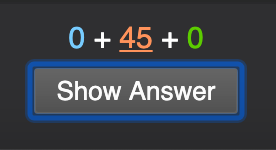
The only other one worth mentioning is the 2.1 scheduler beta. I enable this setting. Some benefits of this (a full list of changes can be found here):

- Reviews show up in random order (This is the most important change, in older versions of Anki reviews would show up in order. I do not think that is best for reviewing information for an exam. How will we be tested, in order? Probably not, let’s mimic test day as much as possible and have our reviews show up in random order).
- Filtered decks work much better (cards stats don’t reset when building or deleting decks)
- Suspending/burying cards doesn’t affect learning steps
- Learning cards now have a “hard” button, this is just the average of your “again” and “good” learning step. So my “again” step is 15 minutes and my “good” step is 1 day so my “hard” step is ~12 hours.

The next setting is the order of cards to be shown. I select “Show new cards after reviews.”

This is because I want to review all of the information that settled in my brain overnight first. Then I will learn any new cards leftover from the day before. Then I will learn the new content for today from third-party content, unsuspend those new cards, then study them.
You can check out my daily study routine here.
Finally, I have the “new day” start at 4 am. This is the time at which the “next day” is registered by Anki. That means cards that are destined for the next calendar day appear at 4 am that day. If you study late into the night or start studying really early in the morning, you might want to change this setting. I am never up past 10 pm studying, and never up before 5 am. So I set it for 4 am.

The last setting worth mention here is the learn ahead limit. This means if Anki pushed a card 15 minutes into the future, as it what happens for me when I hit “again,” if the “learn ahead limit” is 15 minutes, I could review it now (0 minutes after hitting “again”). However, if it is set at 0, as mine is, I have to wait that 15 minutes before I see this card.
I would never change this setting unless you are trying to get through these cards before bed, or need to get through the cards in a short amount of time for some reason.

When you mess with this setting you are messing with the algorithm. We want to minimize that as much as possible. We like the Anki algorithm.
The final setting seems like Anki’s attempt at a Pomodoro built-in timer, or some sort of timer. It isn’t that great. It just will tell you how many cards you’ve reviewed after a certain amount of time.

If I had this as “1 minute,” it would tell me how many cards I reviewed after 1 minute.
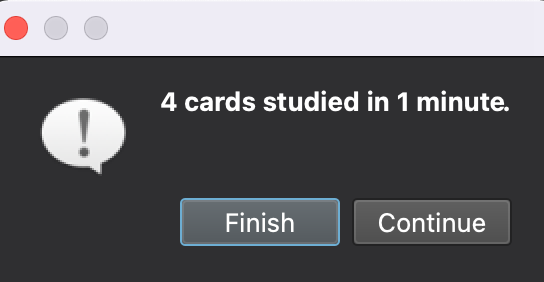
If you hit “Finish,” it takes you out of the deck to the deck browser. If you hit “Continue” you enter into another cycle. I would disable this. There are better Pomodoro timers. The one I use is the Be Focused – Focus Timer available on the Apple store. Another fun option is the Forest timer for your phone. I talk about these in my post here.
Network & Backup
Not much to mention here. I just have the “on next sync” disabled. As I don’t like forcing changes in any direction. These settings will automatically sync your Anki occasionally, with images, and automatically sync whenever you open or close Anki.
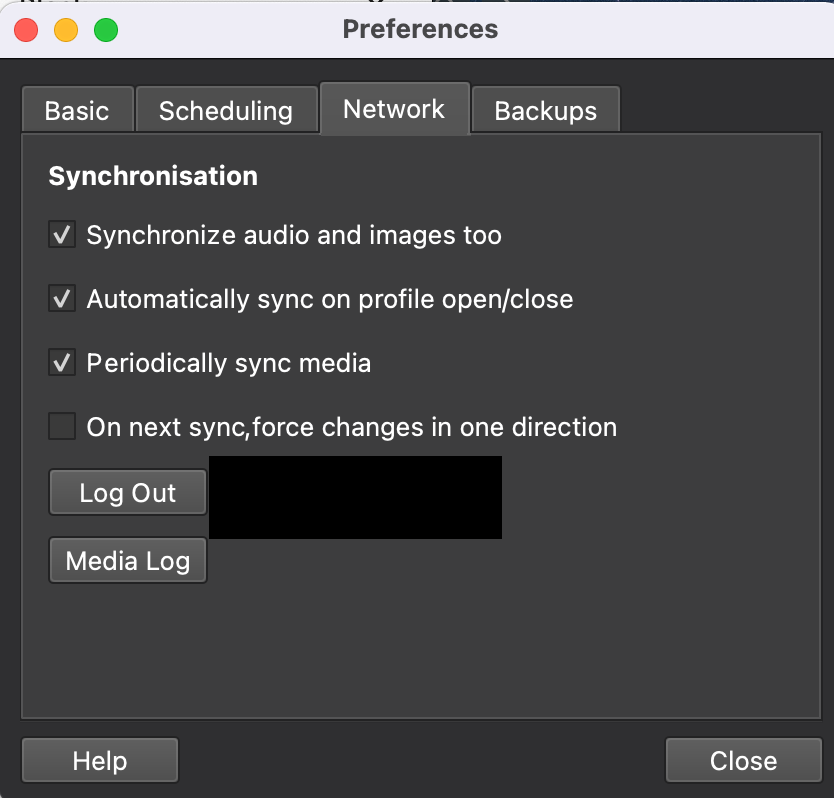
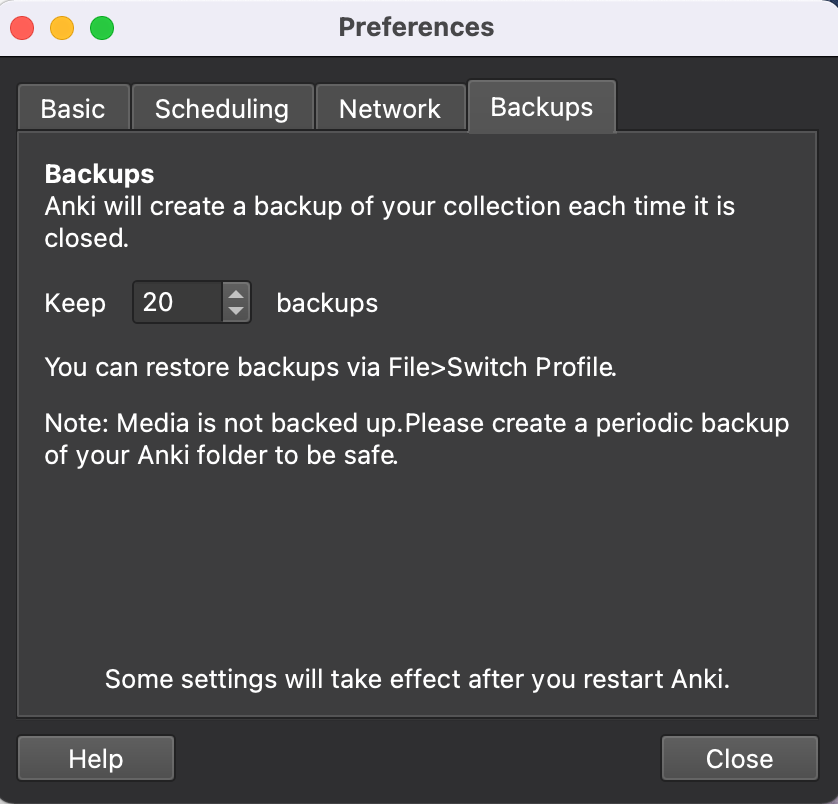
Deck Settings
Now we are on the most important part. The deck settings are going to be what defines how often you see your cards and, therefore, play a large part in your retention of these cards.
Background Information
If you want to just skip to the images of my settings click here.
Learning Anki cards can be separated into two phases. “Learning” and “Graduated.”
When you first unsuspend or add a card it is a new card in the “Learning” phase.
After you complete a certain number of “learning steps” (like hitting “good” at day 1 and hitting “good” again at day 3), your card is “graduated.” Confused? I was too, let’s explain it a little better:
Try and ignore the specific settings, for now, focus on the “Steps.” The “Steps” is your “Learning” phase. I want to give a background of what this all means.
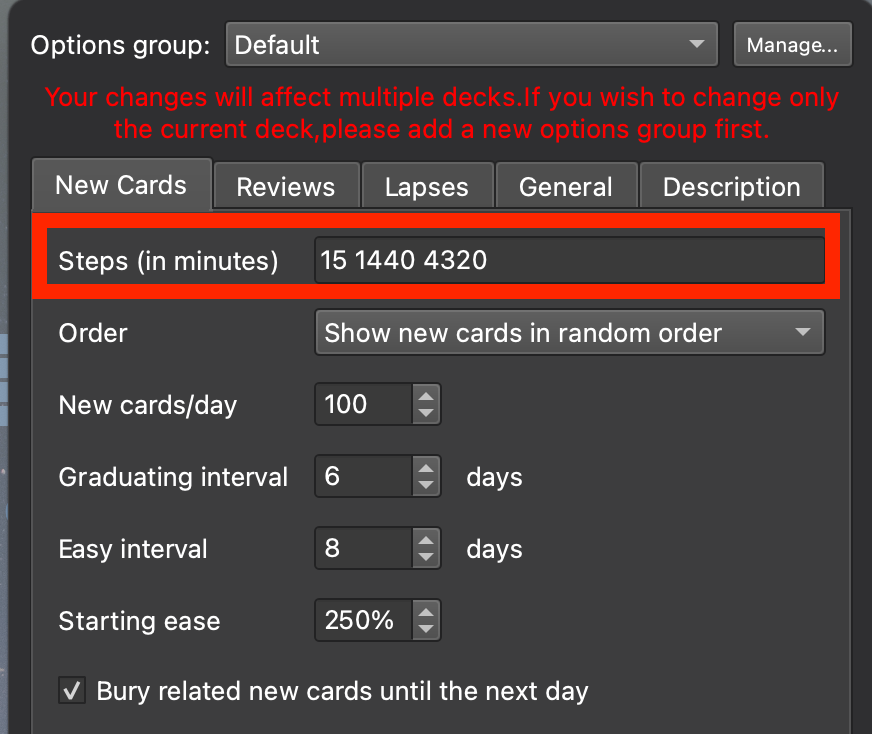
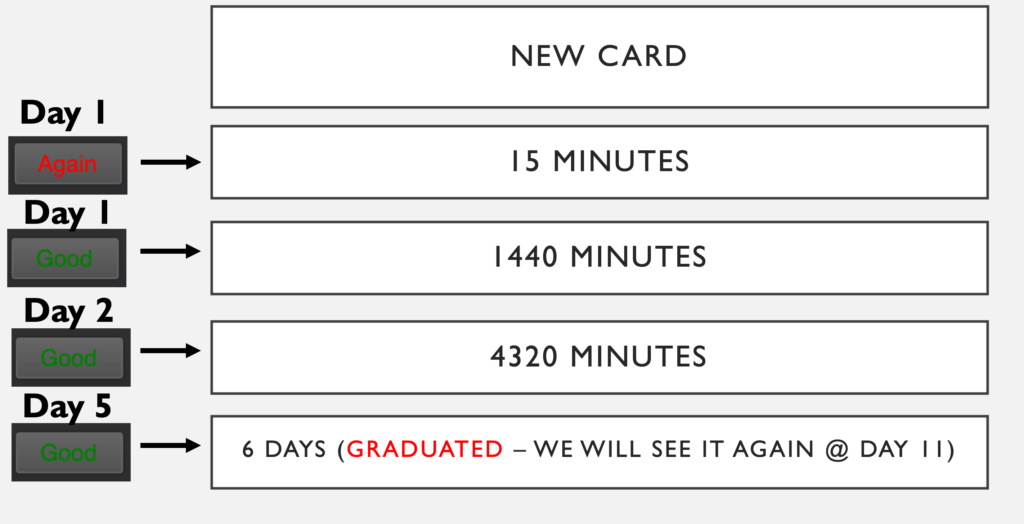
This means, when you are learning a new card you will see it at set intervals depending on what you select:
- If you don’t know it and hit “again,” the card will be shown to you in 15 minutes.
- If you do know it and hit”good,” the card will be shown to you in 1 day (1440 minutes is the number of minutes in one day)
- On day 2, if you still know it and hit “good,” the card will be shown to you again in 3 days (4320 minutes is 3 days) and the card is graduated.
- On day 6 post-learning, the card is graduated and is subject to the normal Anki algorithm (which will be explained shortly)
- If at any point in this “learning phase” you hit “easy” the card will immediately be graduated and sent 8 days into the future. This is the “Easy Interval.”
- If at any point in the “learning phase” you hit “again,” the card is sent back to its first “learning step” and you will see that card again in 15 minutes.
So what is the “normal” algorithm of Anki? And how are our graduated cards treated differently? I’m glad you asked.
Normally, when you hit “good,” it is 2.5 x the current interval. But this only applies to graduated cards. So if your graduated card was at a 1-day interval, and you hit “good,” the card will show up at 3 days, and then if you hit “good” again, at 7 days, and so on…
But there are more buttons, every time you hit one of those buttons, “again,” “hard,” “good,” or “easy,” Anki applies a different algorithm on that card to determine the next time you will see that card.
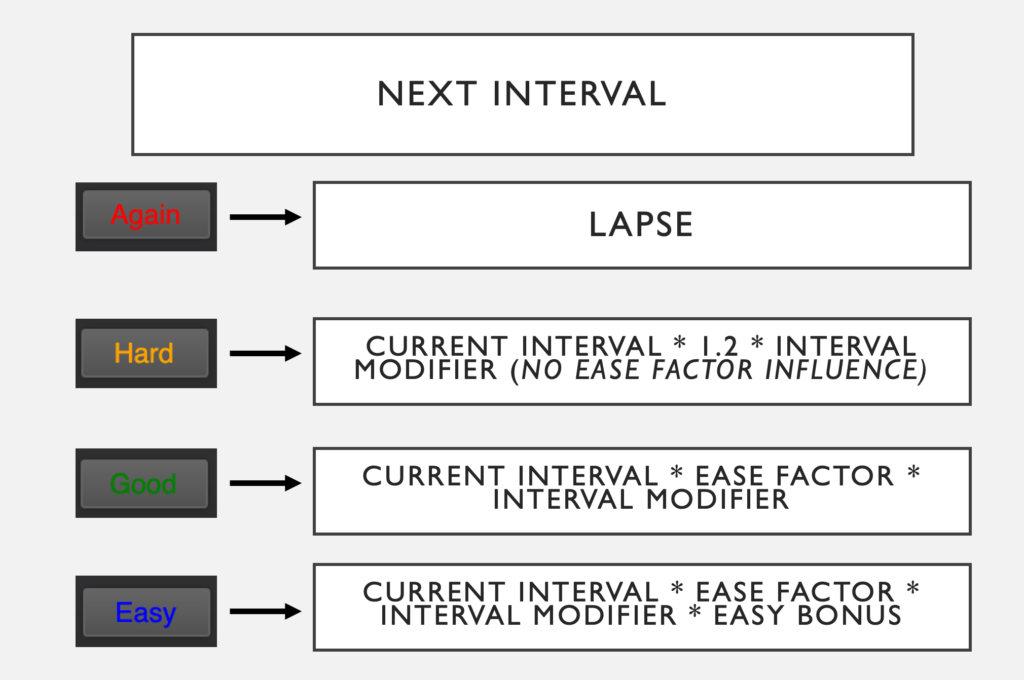
There are many new and confusing terms above, don’t worry about that yet, I will explain all of them as the post goes on. Start by looking at “Lapse.”
A lapse is a card you didn’t know, that’s why you hit “again,” and this card will enter a new “re-learning” phase. This is what happens whenever you hit “again.” What that means is that you will have to relearn that information at a pre-set interval (in settings that we will go over later) before you can “re-graduate” that card.
For example, my lapse settings are:

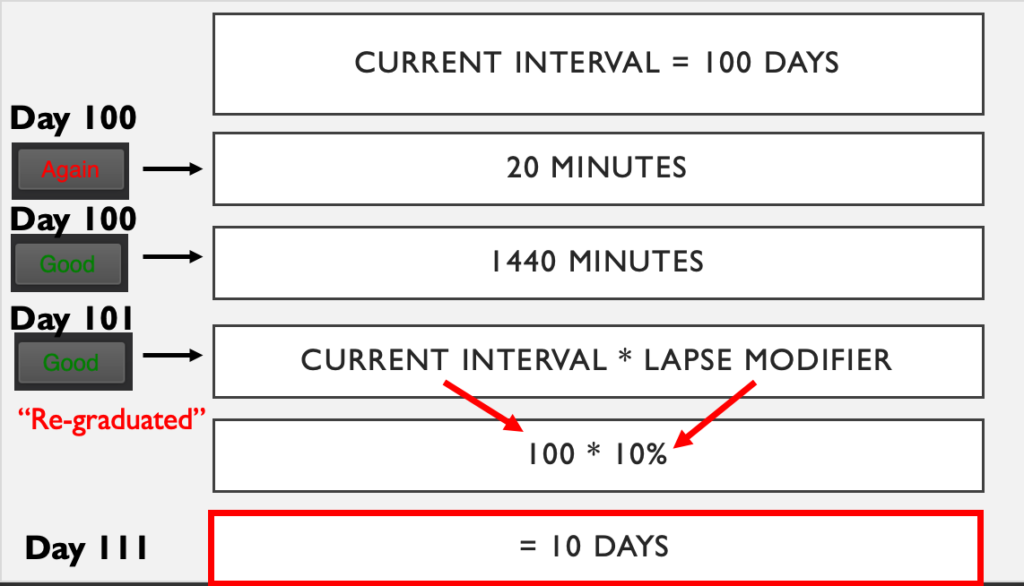
So, if I hit “again” on a card that was at an interval of 100 days I would be shown the card in 20 minutes. Then, if I hit “good,” I will be shown that card in 1 day. Then, if I hit “good,” again I will see that card in 10 days. That card has “re-graduated.”
Why 10 days? Well, my “new interval” is set to 10%. So this means, when I lapse or hit “again” on a card, and I get through my 20 minutes and 1-day re-test, the card is put back on the schedule at 10% of what it was originally. So it was originally 100 days, so now it is 10 days.
Now for the “hard” part.
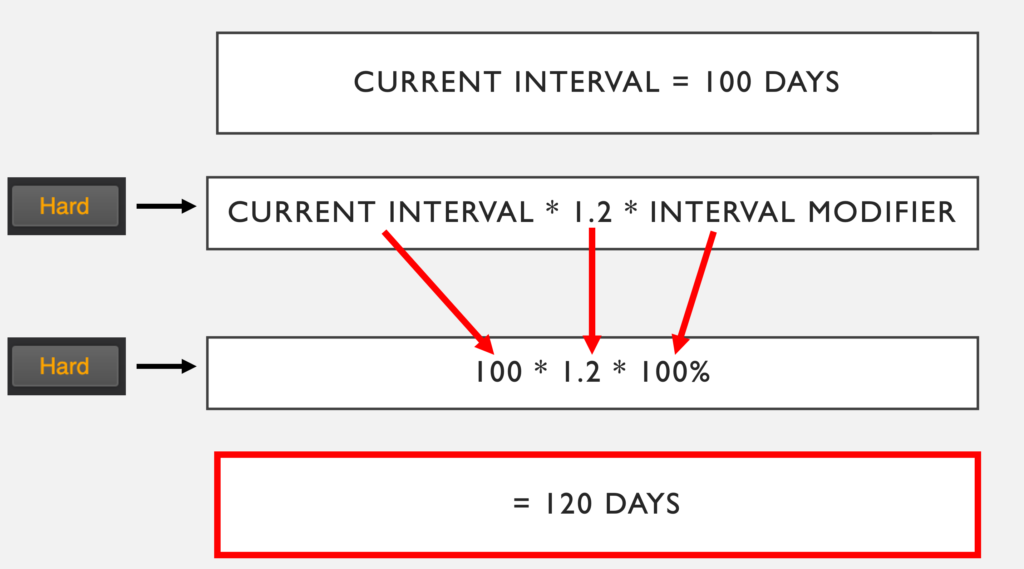
The “hard” button is fairly simple, but what is this new word, current interval?
The current interval is the interval of the card is right now, so let’s use the 100 days example. So the current interval is 100 days, which means I saw this card 100 days ago.
1.2 is exactly that, 1.2.
Interval Modifier is a static number you set in the settings. For now, I will just tell you I leave that at 100%. This means it does nothing as 1*1=1 as far as I know.
So, if we hit “hard,” the card will show up in 120 days.
Now, onto the “good” part.
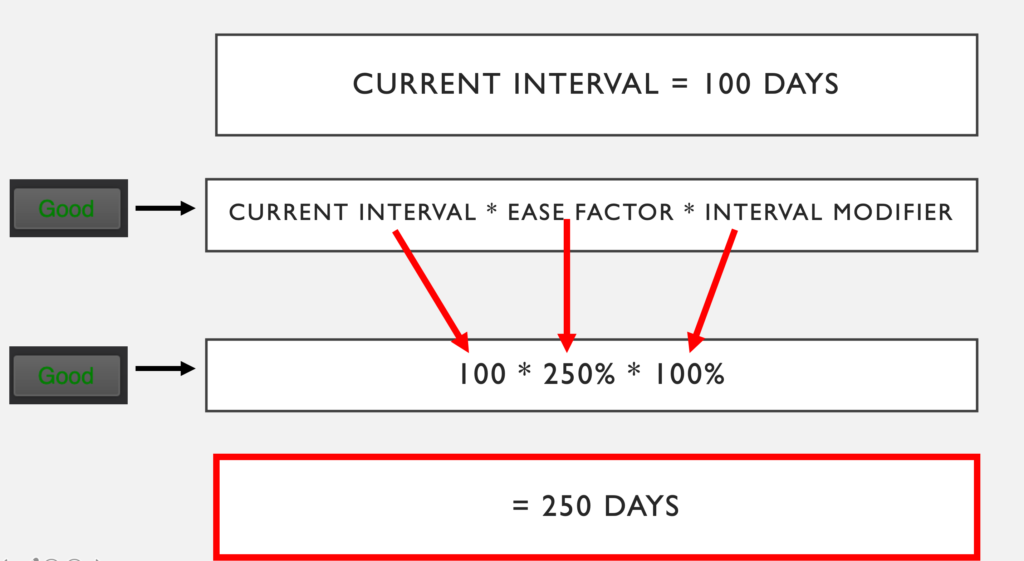
Current Interval we know and Interval Modifier we know, but what is this “Ease Factor?”
The Ease Factor is a unique characteristic of every card. It is initially set at 250%. I recommend never changing this. Importantly, however, Ease Factor will change specific to the card you are doing as you answer “again,” hard,” “good,” or “easy.” So when we have a fresh new graduated card, that has left the learning phase, that card is at an Ease Factor of 250%. Every time we do that card, however, depending on our answer, the ease factor is changed as shown below:
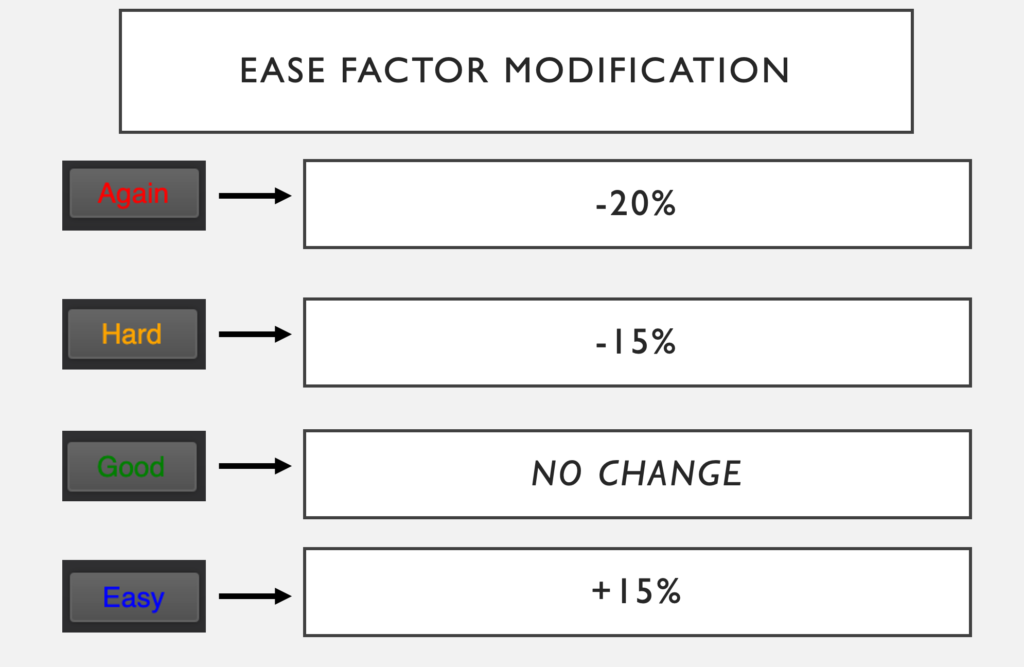
So using our same example of 100 days, if we hit “good” we will see the card at:
Current Interval (100 days) * Interval Modifier (100%) * Ease Factor (250%)
So we will see that card in 250 days.
If we hit “hard” or “again” we would see that card at the interval described earlier, BUT, our Ease Factor for that card is now changed. If we hit “again” the ease factor is now 230%, if we hit “hard,” the Ease Factor is now 235%.
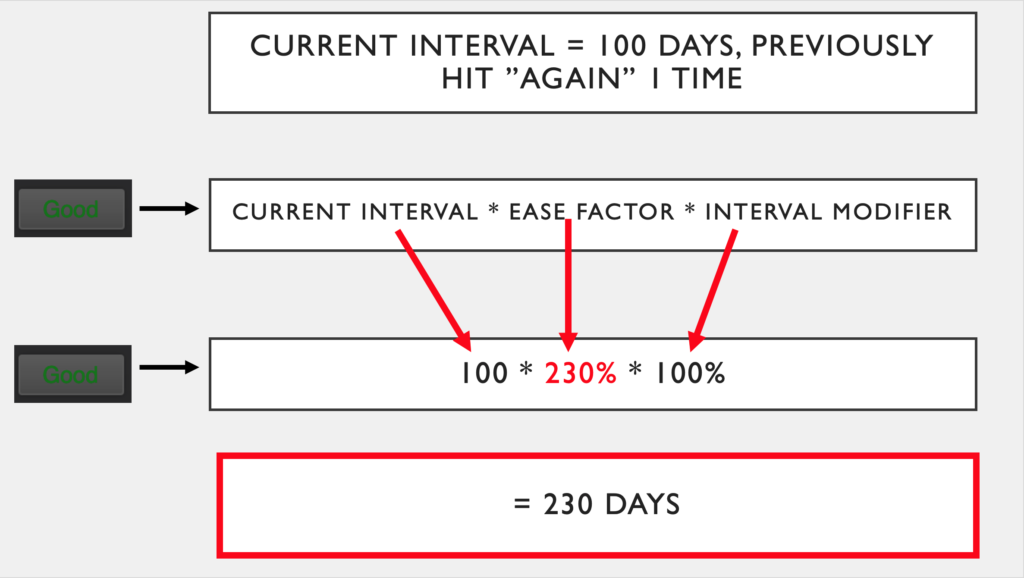
Why is that? Well our Ease Factor is now 230%, so instead of:
Current Interval (100 days) * Interval Modifier (100%) * Ease Factor (250%) = 250 Days
it is:
Current Interval (100 days) * Interval Modifier (100%) * Ease Factor (230%) = 230 Days
I hope this makes sense, as an understanding of this is important for the settings I have.
Finally, we are on to the “Easy” part.
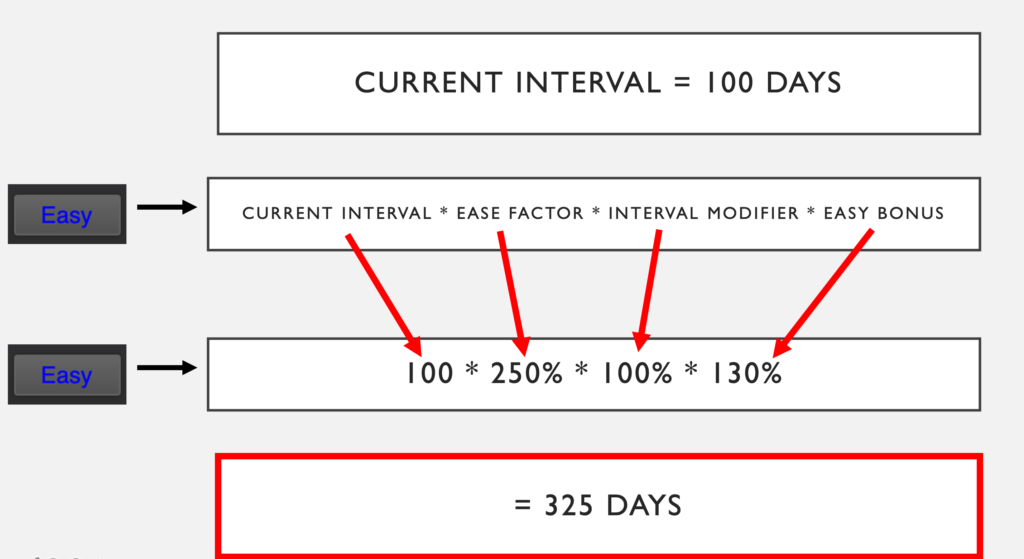
What is “Easy Bonus?”
Easy Bonus is just a static number we can set in the settings, just like Current Interval, that is multiplied to the final interval.
Easy Bonus is normally set at 130%.
Ok, well done if you got through that. I think that information is necessary if you want to get the most out of Anki and understand my settings.
Now, onto the good stuff, onto my settings.
New Cards
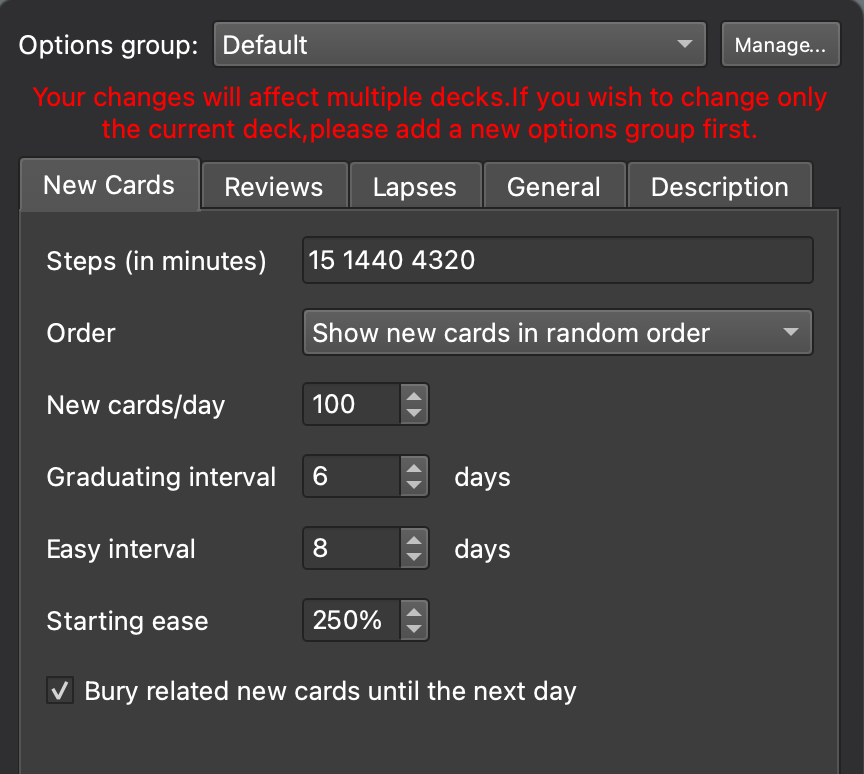
To access this folder go click on the cogwheel next to your deck. I like to keep all my decks the same type, “Default.” As you can see all of my decks are under the “AnKing.”
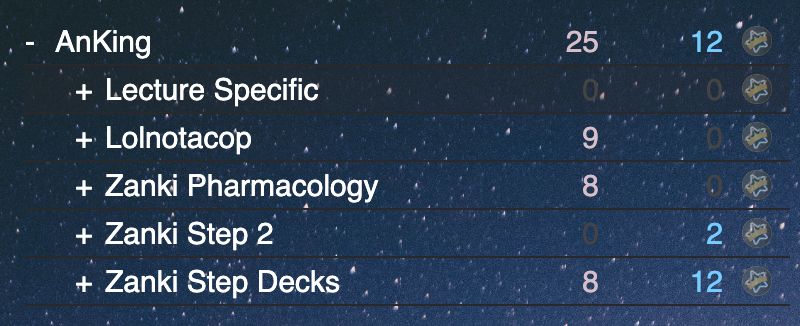
So, this is the important part, what are the steps? Well, we talked about it earlier right. Steps are when your cards are in the “Learning” phase. Here is what I didn’t mention earlier when your cards are in the “Learning” phase, they are safe from Ease Factor modification.
Once cards are “graduated” they are affected by the Ease Factor.
How do we “graduate” cards? Well if we go to the settings of Steps and Graduating Interval, once we hit “good” on our final learning step, the card is graduated and we will see at our “Graduating Interval.”
See New Card → Hit “good” → We see the card 1 day later → We hit “good” → We now see the card 3 days later → we hit “good” → the card is now graduated and we see it 6 days later.
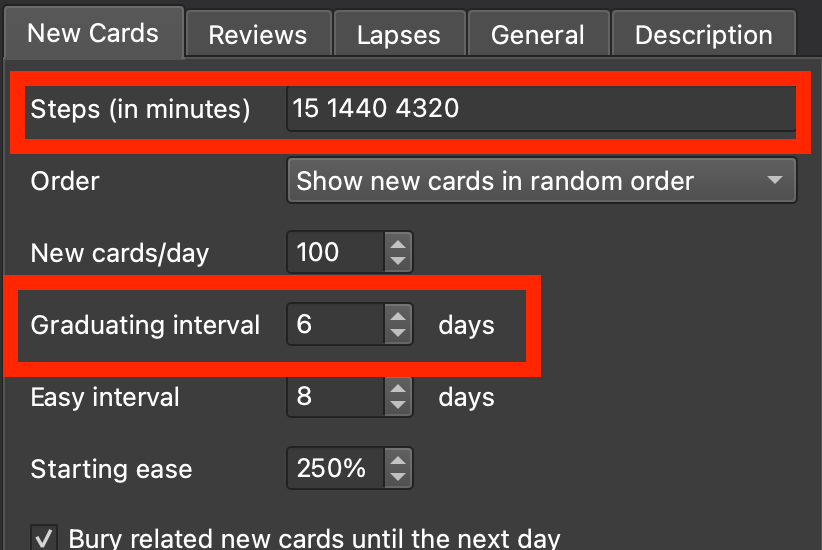
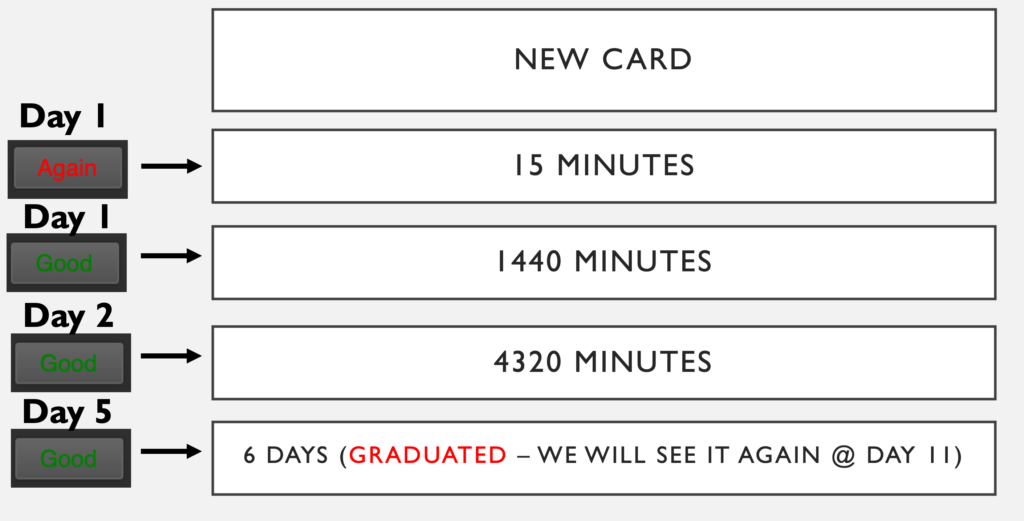
Ok, let’s come back to that mystical Ease Factor. So, while we are doing our learning steps, our Ease Factor is unchanged. That means that any “agains,” or “hards,” we select during the “learning phase,” up until that final learning step (3 days) DOES NOT change the Ease Factor.
So, this means we can hit “again” on our learning cards all we want up until that final learning step (at day 5 post-learning) without affecting the Ease Factor.
Why is this important? Well, when we are first learning our cards things are still just beginning to make sense. It may be a tough day that day, or maybe your brain is being funky, or maybe you just haven’t learned that topic in a lecture that week yet, or maybe your First Aid book is angry with you for not taking out the trash, common medical student problems.
After we hit “again” on a Graduated card 6 times our Ease Factor reaches a minimum of 130%. If this happens to too many of our cards, we enter something called “ease hell.”
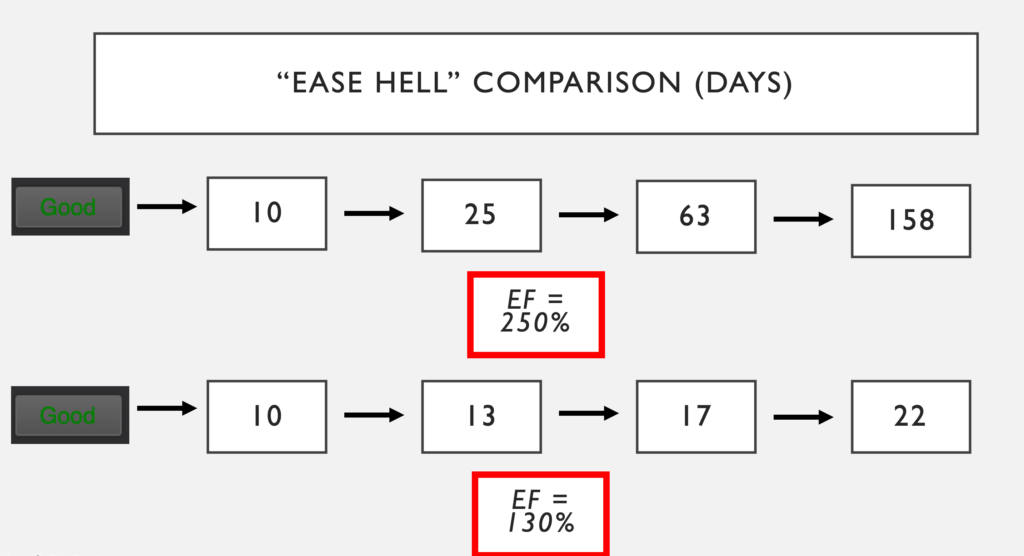
We want to avoid “Ease Hell.” We want to avoid it because we will be seeing too many cards too frequently making Anki unmanageable and inefficient. Anki is an amazing piece of software, but it’s exactly that, software. If we leave the settings as is we are more than likely to enter ease hell.
How I decided on my settings:
All of the points above mean that we do not want to be playing with the well-researched algorithm for maximizing retention that decided on this 250% number, which is why we want some wiggle room in the learning phase (the specifics of the algorithm research was kicked off by Ebbinghaus in 1885, developed upon in 1972 by German Scientist Sebastian Leitner in 1972, and further developed by SuperMemo most recently1,2,3. If you want to check out my full post on the reasoning behind spaced repetition go here).
This is where my individual preference comes in, and you will, and should, change these numbers to maximize your gains and personal preference.
In coming up with my learning steps I referenced two “gods” in the field of medical school Anki and that is the AnKing and Conaanaa.
AnKing’s Steps: 25 → 1440 (1 Day) → Graduated (3 Days)
Conaanaa’s Steps: 15 → 1440 (1 Day) → 8640 (6 Days) → Graduated (15 Days)
Mentionable Option (reddit user – anbu5000): 15 → 1440 → 4320 → 8640 → Graduated (15 days)
My Steps: 15 → 1440 (1 Day) → 4320 (3 Days) → Graduated (6 Days)
In general, I fall somewhere between the AnKing and Conaanaa’s settings. AnKing is harsher, emphasizing high correct rates over more time spent, “put in the extra 30% time for the 5% gains.” Aiming for mid to high 90s % success rate.
Conaanaa’s settings are longer-term, with still high retention, with between 80-90% success rate. His justification being the more steps you add the safer you are from messing with the Ease Factor and, therefore, “Ease Hell.”
My justification for my settings:
- We want to, eventually, start messing with this Ease Factor. This is what helps differentiate specific cards that are more challenging to us or easier to us.
- We are trying to maximize our retention in 1-2 years, not 5+ years (I will adjust my settings towards Conaanaa’s after Step 1)
- In medical school, we may be quizzed on something we just learned that week that’s why I like to see that card at least twice within 5 days.
Many internet sources support Conaanaa’s 80-90% target, however, I had a hard time finding peer-reviewed academic journals in support of this specific number of 80-90%4.
In my opinion, the AnKing makes a good point that we want to be above 90% for maximizing our Step 1 score, however, I think aiming for the mid to high 90s makes the number of cards you have to do unmanageable.
So what did I decide? I want to aim for the high 80s, so maybe 88-90%. This combines those two ideas. These general settings got me in that ballpark, but, really, I haven’t adjusted them for over a year. To fine-tune my way up to 90% I adjust my interval modifier, which, remember is applied to all cards. I will talk about that later, but quickly, if my success rate is too low I decrease my interval, seeing the cards more often. If my success rate is too high, I increase my interval, seeing the cards less often.
Now (thankfully) things get a little more straightforward. Let’s talk about what “Easy Interval” means.
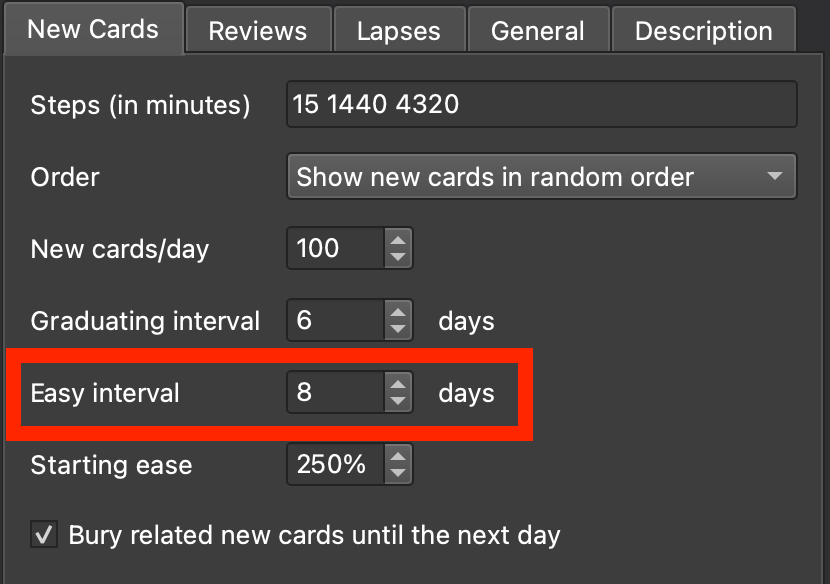
All it means, if that at any point during the learning phase, you hit “easy” the card is immediately graduated and shown to you however many days later you select. I chose 8 days because my graduating interval, of 6 days, is a day shorter than normal as if you applied the normal Anki algorithm my graduating interval should be 7 days. But, remember, we want high retention and exposure in that first time seeing that card, which is why I set it at 6 days.
If you are hitting “easy” you really know that card. I rarely hit easy, so when I do it’s for good reason. I bumped it a day past the normal, so 8 days.
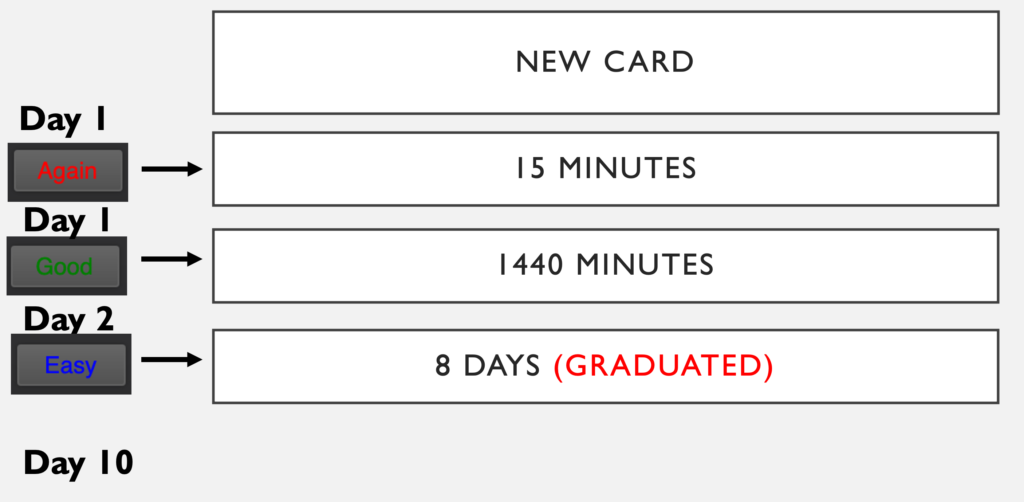
Next is “Starting ease,” remember we don’t want to touch this!! This number was decided upon after many (professional) experimenters decided upon it1-3. I keep mine at the default 250%.

Next, is “Bury related cards until the next day.” I enable this. This makes cards that are related, as shown below, be separated by one day.

As discussed with doing reviews in random order, I like to do my new cards in random order as well. This setting is not as important as doing the reviews in random order, but have found it helps again with avoiding the trap of memorization as we can remember our new cards by the order that the information is being presented in as opposed to actually understanding the information.

What this does is if you have a card like:
2 + 2 = 4
with a cloze deletion of “2” and “4,” the card would appear to you twice as:
2 + __ = 4
2 + 2 = ___
These two cards could appear on the same day, and if they are new cards, and you had this setting disabled, they would appear on the same day. I don’t like that. I feel like I will just remember the answer of “4” from doing the card earlier instead of understanding that 2 + 2 = 4.
A major gripe I have with Anki is it too easy to fall into the trap of memorization, most of my settings are trying to avoid that trap by emphasizing understanding.
How do we emphasize understanding? Well, I think, we avoid using short term memory as much as possible. This is why I have my lowest learning step at 15 minutes and why I have this setting enabled.
We are done with New Cards! Well done.
Reviews
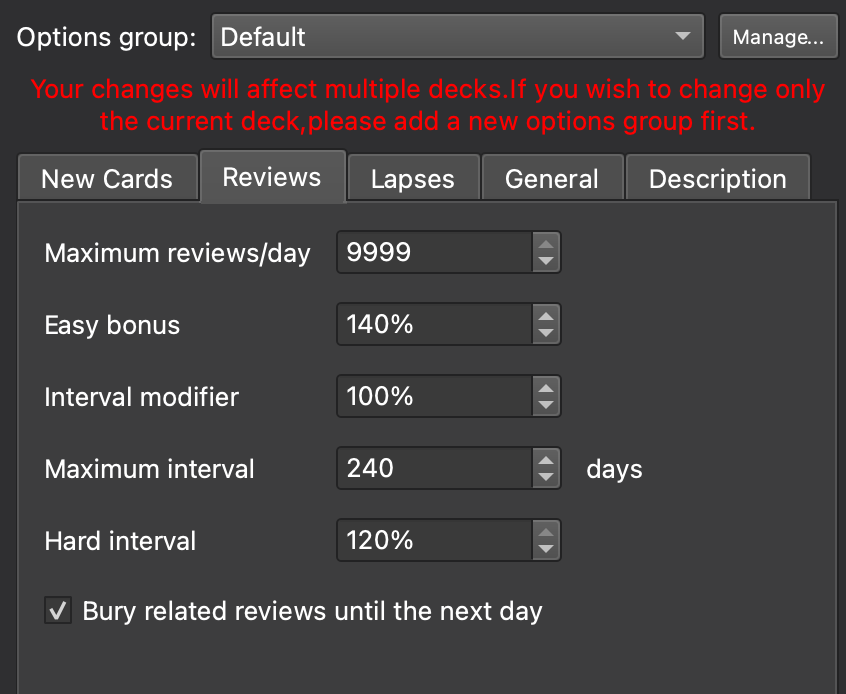
For reviews, the most important setting is the first one. Again, we don’t want to mess with the Algorithm at all. If cards are being pushed to the next day because we maxed out our reviews, we are messing with the algorithm.
Set your max reviews to 9999 and do all of your reviews, every day.
Next is Easy bonus. I set Easy bonus to 140%.

Easy Bonus is fairly straightforward, if you remember this image:
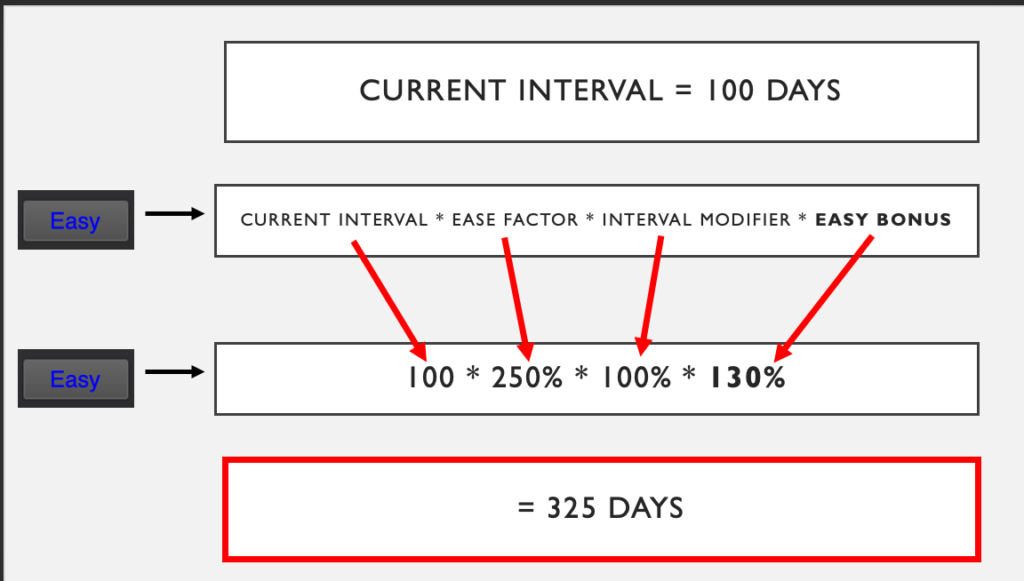
Personally, I rarely hit “Easy.” So when I do it means that card was really easy for me. I just bumped the number up from the default “130%” to “140%.” This isn’t groundbreaking, it just works well for me.
Next, we are onto another very important item, however, one that is easier to understand, the interval modifier. I have changed this number a couple of times, right now, I am happy with it at 100%.

If you are hitting “easy” and “again” and “hard” at the perfect times, maybe, you can avoid changing this number at all. However, sometimes, you are just seeing cards too frequently or too infrequently. Changing this number will alter all graduated card intervals as you are doing your Anki cards. Let’s look at an example assuming you hit good with your Interval Modifier at 100%.
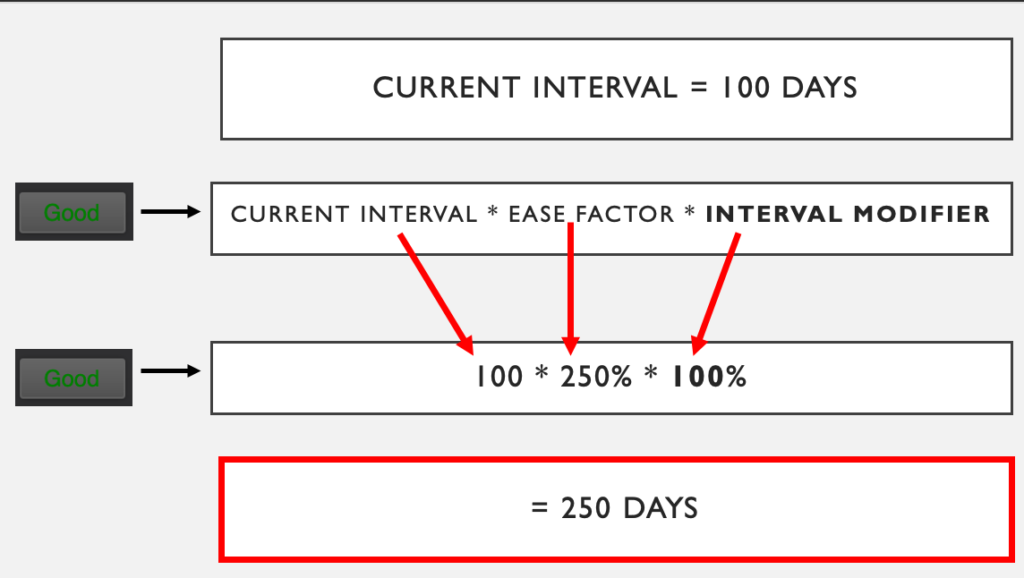
Now if your interval Modifier is 50%.
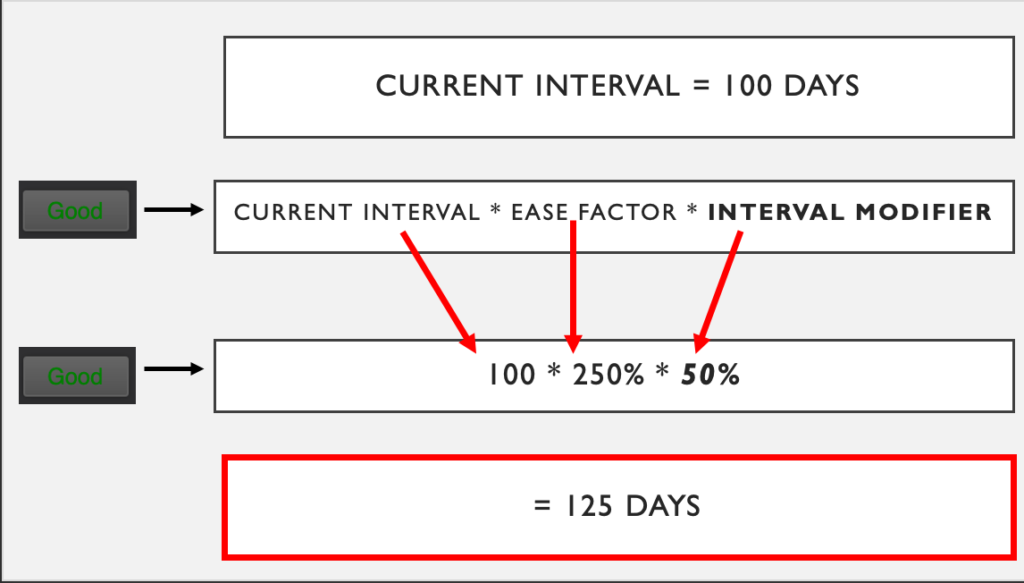
Now let’s compare the two in the long term.
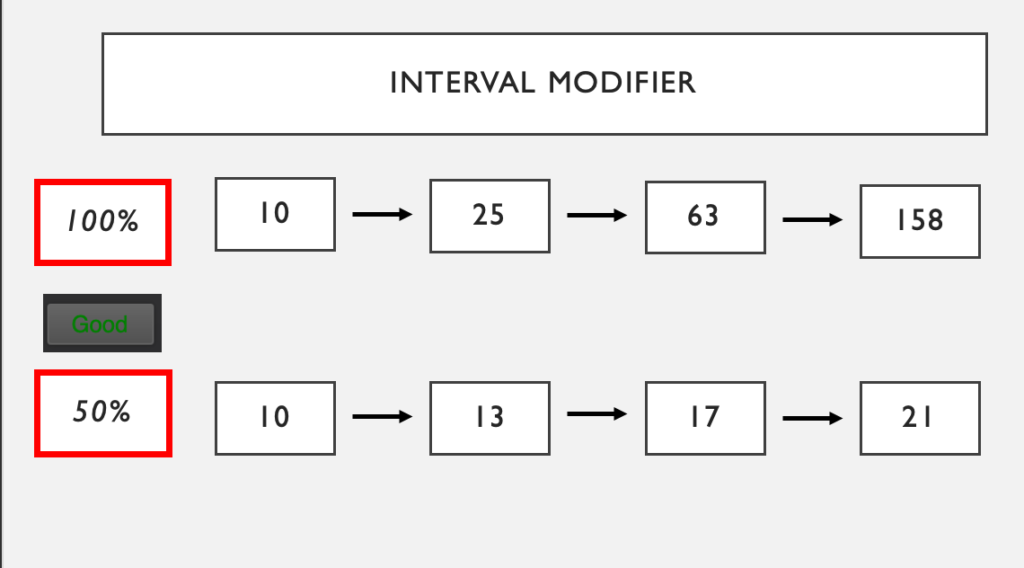
As you can see this makes a big difference, ok, I think you know what it does, now let’s talk about when to change it. If the following is too confusing/scary for you, it’s ok, just leave it at 100% and everything should be fine.
I spoke about this earlier, but, in general, I like to aim for a Success Rate of the very high 80s. My reasoning is that I want to score well on Step, we can score well by having a high success rate, however, as we try and push that success rate up the work exponentially increases (something like 30% extra work for 5% gains). Now, that’s ok for me, to a point. I tried pushing over the 90% hump and my card count got too high. Also, many other people seem to emphasize an 80-90% success rate. So, like finding just the right temperature oatmeal, I decided on trying to hit as close to 90% without passing it. I’m doing pretty well with that.

To get this information just download the true retention app → restart Anki → “Shift-Click” Stats on your deck browser.
What I would do, over the past two years, is monthly I would check up on this number. If I felt I was seeing too many cards, and maybe pushing past 90%, I would increase my interval modifier by 5% to see the cards farther apart.
If I felt I was seeing too few cards, and my retention rate was dropping to the mid-80s, I would decrease my interval modifier by 5% to see the cards more frequently.
So what do I suggest for you? Well, I am pretty happy with my current setup, I don’t think it’s a bad place to aim for at all. Play with that interval modifier, slowly, and carefully and don’t rely on statistics from one day or even one week.
Next things to talk about the maximum interval.

I will defer to a great post by reddit user u/nicolascuri, but he says we should never cap our max interval. I agree with him. Unnecssary repetitions are exactly that, unnecessary.
If you make this number too small like 3 months, the number piles up (yellow line). Interestingly after 6 months (pink line), for me, the increasing of the max interval doesn’t make of a difference via this sumaltion. 1 year is the orange line.
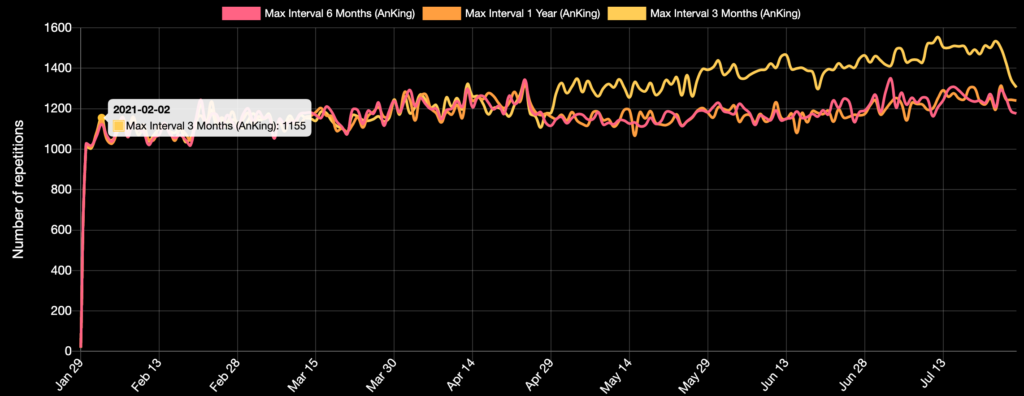
This is using the Anki simulator app which can be accessed here
I recommend setting a max of at least 6 months (180 days) and possibly higher if you want. To be safe, I will officially recommend 240 Days (8 Months) for the first two years of medical school.
Next, let’s talk about the hard interval.

I discussed this earlier, but this is just a static number that applies whenever you hit hard on a graduated card. Don’t change this. I rarely hit hard. I don’t see any reason why you want to adjust this. Just for the sake of spaced repetition…
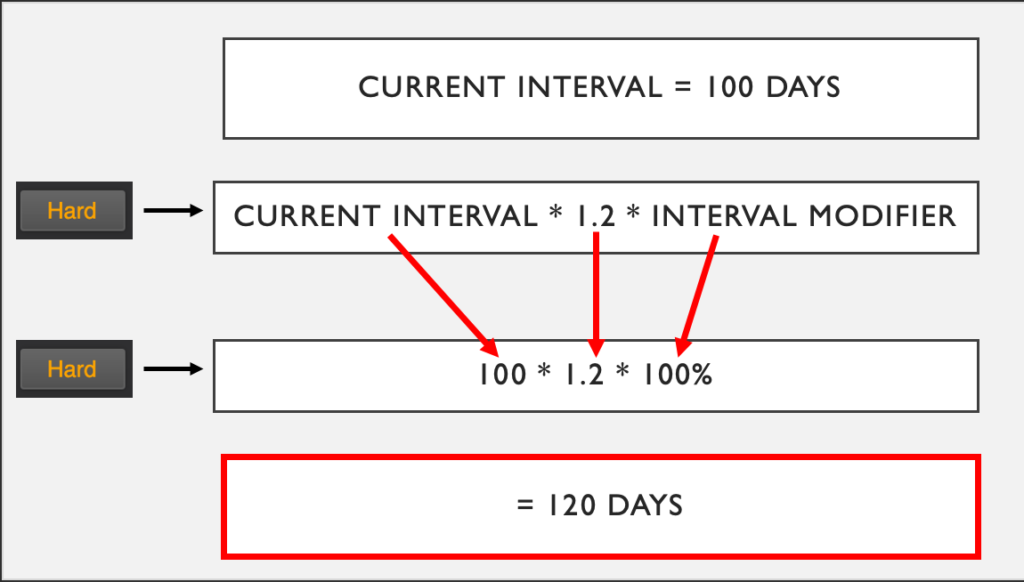
I have bury related reviews until the next day enabled.

As spoke about before, I want to avoid memorization. Let’s apply the “burying” rule to reviews (on graduated cards) as well as “learning” (on new cards).
We are on the home stretch now! Just lapses to do and we are done.
Lapses
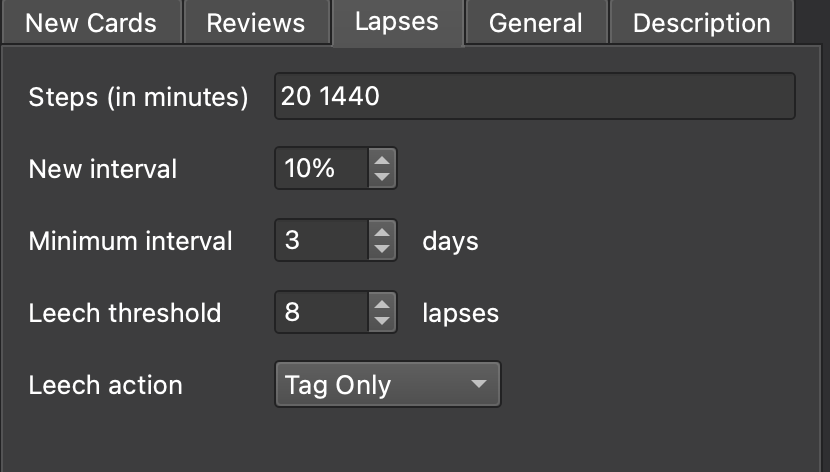
Lapses are what happens when we get a card wrong. If you remember how I described it earlier:
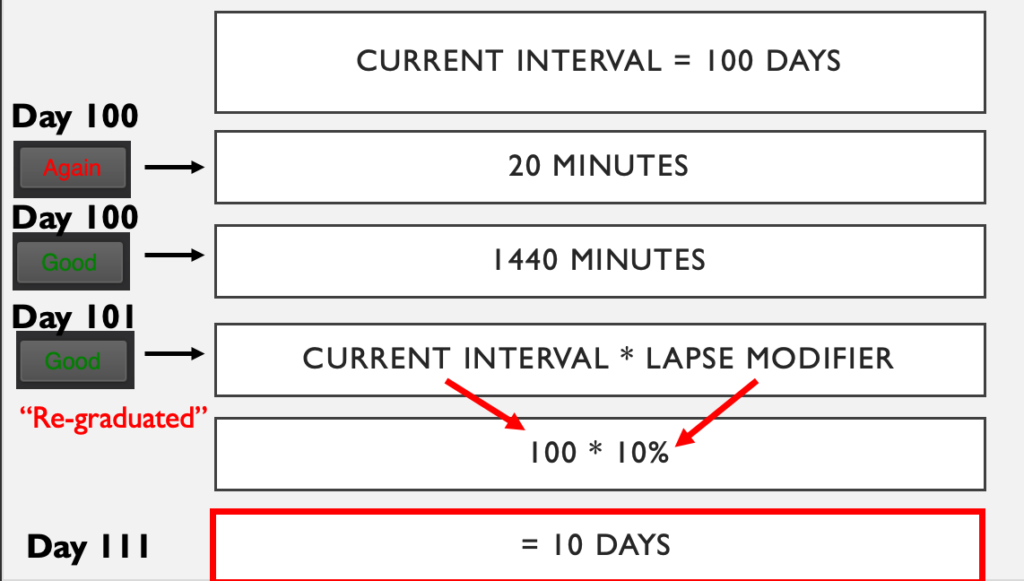

When you get a card wrong it enters “relearning.” It is basically the same as “learning” a card except when you graduate the card its next interval is determined by your new interval %. I put one less interval on the “relearning” phase because I already learned it.

I have my lapse setting at 10% because when I get a card wrong, I usually really don’t know it. I almost need to entirely relearn that card. This is the way I designed my settings. I don’t have it at 0% because that makes the card load too high, and, usually the card will show up too frequently for me.
I experimented with the 80% lapse percentage but it was way too high. I would relearn a card with those steps of 20 minutes and 1 day, then if a card had an interval of 100 days, I would see it again 80 days later. It was definitely not solid enough in my mind to be showed 80 days later, so, what I noticed, is I would get to 80 days with these cards and I would inevitable hit “again,” with no understanding of the card whatsoever.
I suggest you set it at 10-30%. I like the 10% number.
Often, however, 10% of my current interval of a card drops the next interval to below a day. That’s where this setting comes in:

This means, that say I have a card with an interval of 10 days, I get this card wrong. 10% of 10 days is 1 day. I don’t want to be reviewing this card at 1 day → 1 day, that is silly, and against the algorithm, so I don’t.
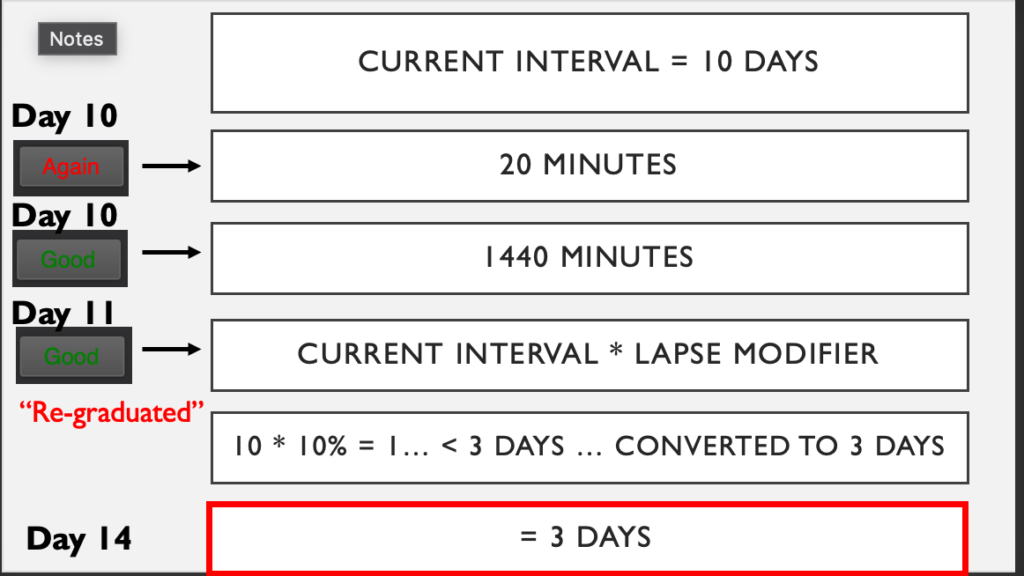
Now, let’s talk about leech threshold and leech action.

What this means, is if you hit “again” 8 times on a graduated card the card will be tagged as a leech.
I do not think the “suspend” setting is a good idea. We want to do really well on Step 1, this means we want to learn these cards that are a struggle for us, not push them to the side.
The other thing to note is that if you have hit “again” 8 times your card has hit the floor of the Ease Factor. So your Ease Factor is at 130%. That’s OK though, remember, we adjusted for the learning phase with our learning steps. So if the Ease Factor is at 130% now it is meant to be there, you need to look at this card, and you need to keep looking at this card.
I can track my leeches and time spent on individual cards, about monthly, I will check the cards that are taking me the most time and take some time to learn the facts that are my sticking points.
side note: if you want to track your leeches, and the time spent on every leech, I suggest you download the advanced browser app, which will let you customize your browser to sort for “time spent” on certain cards.
General
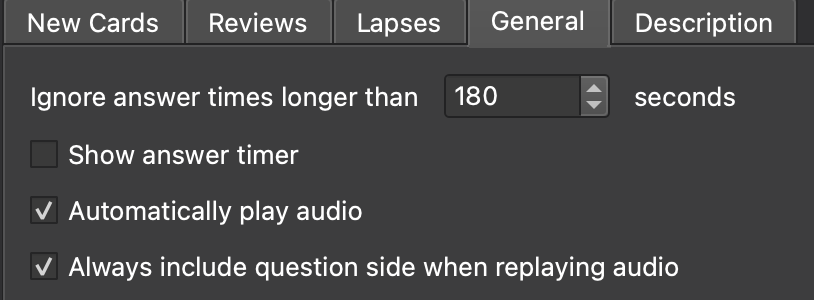
These settings are straightforward.
If I get up from my desk, or look at a card for longer than three minutes, Anki assumes me as “afk” and ignores the answer.
I do not like to show answer time as it is distracting.
On the few cards that have audio, I like that to play immediately after I answer.
Fuzz Factor
As an extra piece of information, Anki has a built-in “Fuzz Factor.” What this means is that, on all cards, a different interval will be applied to cards from 80-120% of what the interval would be without the fuzz factor regardless of what button you press.
So when you press any button, Anki may give that card an interval of anywhere between 80 and 120 days. This isn’t such a huge difference that it’s messing with the Anki algorithm. This is just put in place so when you introduce new cards, you won’t have to review all of them on the same day.
Honestly, for our situation, this doesn’t make much sense as we are doing new cards pretty much every day, but, if, for example, you did TONS of new cards on one day, and not so much on another day, this would help balance the load.
If anyone has used load balancer (which I don’t recommend using because load balancer really does mess with the algorithm), this built in function is like that.
Final Tips
You must be honest with yourself. “Tip of the tongue” is not good enough. Hit “again.”
If a card is showing up too much I just hit “easy.” If this is happening across the board I think about changing my interval modifier.
I continuously edit, add images, and practice the Feynman Technique with individual cards.
Otherwise, we did it! Thanks for reading and I hope this was helpful.
-Zach
Pictures of My Recommended Settings For Medical School
Work Cited:
- Murre JM, Dros J. Replication and Analysis of Ebbinghaus’ Forgetting Curve. PLoS One. 2015;10(7):e0120644. Published 2015 Jul 6. doi:10.1371/journal.pone.0120644
- Leitner, S. 1. (1991). So lernt man lernen: [angewandte Lernpsychologie – ein Weg zum Erfolg] (Sonderausg., 16. Aufl.). Freiburg im Breisgau [u.a.]: Herder.
- http://www.cc.kyoto-su.ac.jp/information/tesl-ej/ej40/m1.html
- https://eshapard.github.io/anki/target-an-80-90-percent-success-rate-in-anki.html
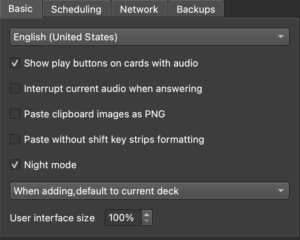
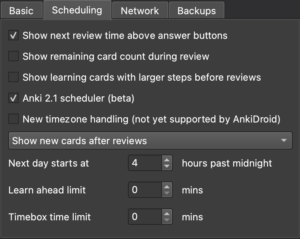
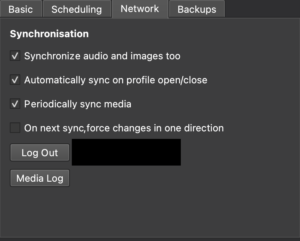
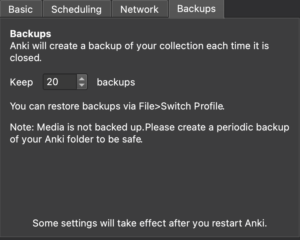
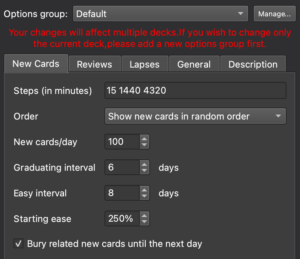
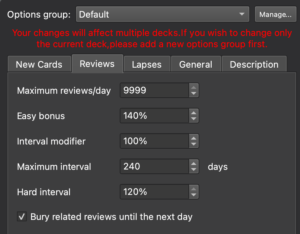
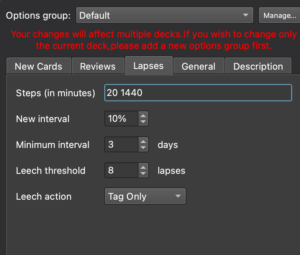
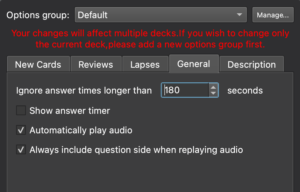
34 Comments
Aditya · February 8, 2021 at 10:28 am
Conaanaa has changed his anki settings. For more info, visit the comment section of his ‘Anki settings’ video. Here is are my anki settings: (only modified settings, rest are defaults)
New Cards-
Step 15,1440,5760
Graduating interval 10
Easy interval 15
Reviews-
Maximum interval 180
Lapses-
Steps 20,5760
New interval 50%
Learn ahead limit 20 mins (It helps to complete the task in one seating)
I am not using the v2.1 scheduler.
What do you think? (Mature retention is around 80-85%)
Zach · February 8, 2021 at 1:04 pm
Looks good to me! Depending on how long you are learning for extending the maximum interval might be the only thing I would change.
Aditya · February 12, 2021 at 10:44 am
After a lot of consideration, I decided to use your recommended settings. It’ll take some time to get used to it (w/ v2.1 scheduler enabled). Though, I have a good feeling as I am consuming facts/data.
Kindly, accept my congratulation, I remember you making the 1K subscription video like it was yesterday, and now look at your number of subscriptions.
This must be a crazy yet happy journey for you and as an early follower of yours, I’ll take this lesson. “It’s never too late to start, bring quality with consistency, hard work pays off.”
Once again, thank you for the comprehensive guide of Anki’s settings!
Dharini · April 14, 2021 at 3:26 pm
I’m a medical student and very recently saw your videos in youtube. And I’m glad that I saw them:). I’M new to anki and have no idea about it. I’ve just downloaded it in my laptop(windows 10). There’s no tool bar and preferences. idk if I’ve downloaded an older version and idk which version to download… pls help me
someOneOnTheInternet · May 16, 2021 at 3:11 pm
You can access the preferences menu directly by using shortcuts “CTRL + P” and for Deck options you first need to make your own deck or download pre-made decks like “Anking’s Step 1 deck”. After you download and import the deck you should see a cog wheel appear rt next to it, left click on it and chose the “options” menu.
Bennett · April 17, 2021 at 3:04 am
Can you describe what goes through your mind when you’re looking at a card and deciding whether to select again, hard, good, or easy? And how often should you be hitting each of these options?
Also, does your thought process change if the card is new? And what about if it’s already learned and an exam is a month out vs a few days out? Thanks!
Zach · June 1, 2021 at 6:37 pm
Easy – I knew it within 2 seconds and didn’t require much mental effort at all
Good – Normal difficulty, maybe 1-10 seconds of thinking, I had to think about it but knew the answer
Hard – (I rarely (<1%) of the time use this option, but it's if I know a card but it took me over 30 seconds to figure it out)
Again - If I do not know the answer (be honest!)
Jane Doe · July 15, 2021 at 1:42 pm
I love your videos! Just wondering, do you recommend your settings for an incoming MS1 who plans to start Day 1 and will have a P/F Step 1?
William · September 8, 2021 at 11:59 am
Hey Zach,
I am William from a tiny island called Singapore, In less than 1 month I will be taking my GCSE N levels, I need a short term setting for Anki so that I review cards at the correct time within this 1 month, I tried your settings and I am unsure if it is suited for a 1-month duration. I also want to thank you for introducing me to the best study methods through your videos. You have truly made an impact on how I study, Wishing you all the best in making videos!!!
Zach · October 11, 2021 at 3:29 pm
Hey, the settings will still work, you could set the “max interval” to 14 days just in case.
Sal · November 20, 2023 at 2:14 pm
Hi Zach, what max interval would you recommend for pre-med prerequisite courses? Are there any other settings you would change from the ones you listed above?
Zach · September 13, 2024 at 7:30 am
Max interval should be a million years. The way the algorithm works the idea is to know it forever. I would only reduce it for short periods of time if you have a quiz or something, but, otherwise if you are using it properly the max interval doesn’t matter and should be very long in the future.
Morgan · September 15, 2021 at 2:50 am
I entered in the settings exactly and it keeps showing me for my intervals. Again: 15m, Hard: 1 d, Good: 1d, and Easy 7d. Is this right? I thought good would be shorter. What should I change? Thank you.
Zach · January 17, 2022 at 1:07 pm
Hey, for learning cards, my settings have the interval 15 minutes (when you get it incorrect), 1 day (when you hit “Good”), 3 days (4320 minutes, when you hit good on that same card for a second time), and 6 days (when you graduate your cards). Make sure you have these settings applied to the deck you are working with. Some decks may still be running the default options. The reason I say that is my “Easy” settings are “8 days” and not 7d, are you sure the deck you are working with has these settings applied?
Don’t worry about Hard so much, Hard just affects the ease factor and makes the card ALWAYS appear 1.2 times whatever the interval is, so if you are set to see it in 100 days, you will see it in 120 days, as opposed to when you hit “good” where it might appear in 250 days.
Does that answer your question? I would check the settings are correct and applied to the deck you are working with.
Kay · October 19, 2021 at 9:39 pm
I am having this same problem! Did you figure it out?
Zach · January 17, 2022 at 1:08 pm
Hey I replied to the person above, let me know if that fixes it! Double check the settings and that the settings are being applied to the deck you are working with.
Karo · January 14, 2022 at 12:23 am
I entered the settings and I’m having the same problem.
Zach · January 17, 2022 at 1:09 pm
Hey I replied to the person above, let me know if that fixes it! Double check the settings and that the settings are being applied to the deck you are working with.
Marcos · January 20, 2022 at 5:23 pm
Hey Zach! Thanks for your post, very well written content.
My deck is with the max interval set at 180 days. I was just browsing my cards, and some of them are scheduled to be reviewed a year from now. It looks like the cards are not ‘obeying’ the maximum interval setting of 6 months. Is this behavior expected?
Once again, thank you for your content, and cheers from Brazil.
Hyka · September 30, 2022 at 3:31 am
Hey can there be an update to the settings, as my interface looks different from yours. It would be quite appreciated, thank you.
Zach · November 3, 2022 at 7:11 am
Hey Hyka, I have a new “class” coming out in December that will outline the settings in the new version, for now you can just do this: Hold Shift while you’re clicking on the settings gear symbol and continue to hold it while you’re clicking on “Options,” and you will see the old interface.
Van · February 1, 2023 at 6:31 pm
Thank you for taking the time to explain all of this. I am not a medical student but the care and precision allowed me to start to adapt the Anki setup into my routine, with knowledge.
Again thanks!
Zach · February 14, 2023 at 7:04 pm
Glad it helped!
Faseeh · April 9, 2023 at 3:37 am
I have just stared preparing for my supply chain exam (CSCP) and found Anik and this article and your skill share course really useful. I am also watching your skill share course, thanks for sharing it for free. All the best wishes for your medical exams – Faseeh
Zach · April 21, 2023 at 9:59 am
Us students need to help each other out! Thanks for following me!
Teodorio S. Melquiades · April 12, 2023 at 5:51 pm
for a short-term test should I limit the maximum interval to half the time or not
Zach · April 21, 2023 at 10:00 am
Honestly it really doesn’t make a difference if you are following this algorithm because after you take the test you will just suspend all the cards.
Jimmy · August 18, 2023 at 9:34 pm
I am using these exact same settings and I also have the V3 scheduler on, On my third day of anki, the new cards had the same interval for hard and good. Specifically, instead of the “15 min, 12.1 hours, 1 day, 8 days” the intervals were now “15 min, 1 day, 1 day, 3 days.” Is this how it should be? Again, all my settings are exactly as recommended in this article – please let me know if I should keep this or if there is any fine-tuning i should do with the V3 scheduler on. Thank you!
K · November 12, 2023 at 8:47 pm
I have the same issue! Would love to know if you figured out how to fine tune the v3 scheduler. Thanks.
Zach · November 18, 2023 at 8:51 am
Yeah it’s not telling you but it’s actually likely “1.2 days” but it displays as 1 day on Anki.
Fredbaby · October 3, 2023 at 8:34 pm
the new interval is now under “advanced settings”. is it still the same “new interval” you were showing?
Fatma · November 3, 2023 at 9:00 am
Thank you Zach for this beautifully done explanation, i was stuck for not understanding how the algorithm works especially for graduated cards to maximize my efficiency while using all those buttons :).
I’ve also watched your recent video on Anki settings “Essential Anki Settings I Wish I Changed Sooner”, and I’ve noticed that you’re using a different setting from what is shown in this article.
I’m aware of the time between these two videos and you are in different studying stages, I want to ask you about the best settings to go with for me out of those two settings you’ve used, as I’m currently and IMG graduate and preparing for USMLE Step 1 in a year.
Zach · November 18, 2023 at 8:54 am
I would use my settings here at the bottom of the post (15 1440 4320) 6 days 8 days. That is the most up to date.
Understanding Anki's Settings - Richard Coward · August 12, 2021 at 2:22 am
[…] Anki Settings: A Complete Guide and Recommended Settings For Medical School […]